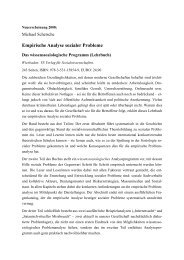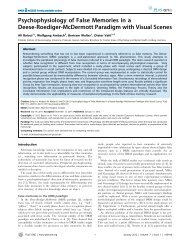2 Projects and Results - IGPP
2 Projects and Results - IGPP
2 Projects and Results - IGPP
Create successful ePaper yourself
Turn your PDF publications into a flip-book with our unique Google optimized e-Paper software.
Theorie und Datenanalyse 3<br />
e.g. chaotic, this requires that the partition providing these<br />
states be generating (or, more specifically, Markov). Generating<br />
partitions are defined by the dynamics of the neural<br />
states <strong>and</strong> give rise to particular, dynamically stable equivalence<br />
classes of neural states that can be re-defined symbolically<br />
as mental states. As a consequence, we suggest<br />
that the program of a unified science of psychology, with<br />
mutually compatible domains of description, depends on a<br />
proper choice of partitions of the neural state space.<br />
Atmanspacher; together with beim Graben<br />
Publication: beim Graben, Atmanspacher (2008)<br />
Necker-Zeno Model for Bistable Perception<br />
The Necker-Zeno model for bistable perception, inspired<br />
by the quantum Zeno effect, was previously used to relate<br />
basic time scales of cognitive relevance to one another in<br />
a quantitative manner. The model predictions have been<br />
compared with experimental results obtained under continuous<br />
<strong>and</strong> discontinuous presentation of ambiguous stimuli.<br />
In addition to earlier results of increasing “dwell times” (inverse<br />
reversal rates) for increasing <strong>and</strong> long inter-stimulus<br />
intervals, we have shown that the reversal dynamics according<br />
to the Necker-Zeno model is also in agreement with new<br />
observations for increasing dwell times for decreasing <strong>and</strong><br />
short inter-stimulus intervals.<br />
These results are non-trivial since they represent opposing<br />
trends for long <strong>and</strong> short inter-stimulus intervals, separated<br />
by a critical time scale of the order of 300 msec. Moreover,<br />
the model accounts for the experimentally observed<br />
distribution of dwell times <strong>and</strong> permits an experimental distinction<br />
between different attentional effects. The Necker-<br />
Zeno model also suggests modifications of cognitive time<br />
scales under conditions of psychopathological impairments<br />
<strong>and</strong> meditation-induced modes of awareness.<br />
Atmanspacher, Filk, Kornmeier, together with Bach, Römer<br />
Publications: Atmanspacher, Bach, Filk, Kornmeier, Römer<br />
(2008), Atmanspacher, Filk, Römer (2008)<br />
Temporal Nonlocality of Mental States<br />
The concept of temporal nonlocality refers to states of a<br />
system that are not sharply localized in time but extend<br />
over a time interval of non-zero duration. We investigated<br />
the question whether, <strong>and</strong> how, such a temporal nonlocality<br />
can occur in mental processes. For this purpose we exploited<br />
the empirically supported Necker-Zeno model for<br />
bistable perception, which is based on non-commuting operations<br />
implying an option for nonlocal states. We derived<br />
so-called temporal Bell inequalities <strong>and</strong> demonstrated under<br />
which conditions they can be violated in this model,<br />
indicating temporal nonlocality. Finally, we proposed an<br />
experimental realization of such a violation <strong>and</strong> discussed<br />
its important consequences for our underst<strong>and</strong>ing of mental<br />
processes.<br />
Atmanspacher, Filk<br />
Publication: Atmanspacher, Filk (in press)<br />
2.1.3 Multistability <strong>and</strong> Acategoriality<br />
Adaptation <strong>and</strong> Priming in Bistable Perception<br />
Interpretations of ambiguous figures have stimulus- <strong>and</strong><br />
observer-specific probabilities. The observation of an unambiguous<br />
version of an ambiguous figure (“conditioning<br />
stimulus”) can bias these probabilities toward higher values<br />
for either identical (priming) or opposite (adaptation) interpretations<br />
of the subsequently presented ambiguous figure.<br />
We compared such conditioning effects for different<br />
types of ambiguous stimuli at different levels of abstraction<br />
(ranging from pictures to words). For low-level conditioning<br />
stimuli we found very similar adaptation effects<br />
across ambiguous figures. Words as conditional stimuli<br />
cause priming effects, but only for semantic types of ambiguous<br />
figures. Our results indicate that bistable perception<br />
can be influenced at different levels along the processing<br />
chain.<br />
Kornmeier; together with Bach, Wörner; funded by DFG<br />
Bottom-up versus Top-down Mechanisms<br />
Prolonged observation of an unchanged ambiguous figure<br />
leads to sudden perceptual changes. Two alternative explanatory<br />
approaches assume either bottom-up or top-down<br />
mechanisms underlying this phenomenon. We investigated<br />
the interrelation of two factors, both strongly modulating<br />
the rate of perceptual reversals <strong>and</strong> each being interpreted<br />
as evidence for one of the two explanatory approaches: volitional<br />
control (top-down) <strong>and</strong> discontinuous stimulus presentation<br />
(bottom-up). We found that both factors strongly<br />
modulate reversal rates, operating independently of each<br />
other on different time scales. It turns out that the two<br />
explanations are not mutually excluding alternatives (as in<br />
many current discussions) but need to be integrated in a<br />
more comprehensive picture.<br />
Kornmeier; together with Hein, Bach<br />
Publication: Kornmeier, Hein, Bach (2009)<br />
EEG Correlates of Binocular Rivalry<br />
Binocular rivalry occurs when each eye views a different<br />
image <strong>and</strong> visual perception alternates irregularly between<br />
them. In a discontinuous presentation study where endogenous<br />
alternations were synchronized with stimulus onset we<br />
recorded event related potentials (ERPs) <strong>and</strong> compared the<br />
results with a situation where both eyes view identical gratings<br />
which were simultaneously replaced by an alternative<br />
pair of identical stimuli. We analyzed ERPs from pre- <strong>and</strong><br />
post-alternation intervals. In the case of rivalrous stimuli an<br />
occipital ERP signature occurring about 1000 ms before the<br />
onset of the alternate stimulus predicted a perceptual alternation.<br />
We propose that this ERP signature is a marker of<br />
destabilization making the perceptual system susceptible to<br />
small perturbations.<br />
Kornmeier; together with Roeber, OShea; funded by DFG<br />
EEG Correlates of Object Representation<br />
Slight figural modifications can change an ambiguous <strong>and</strong><br />
perceptually unstable visual stimulus to an unambiguous



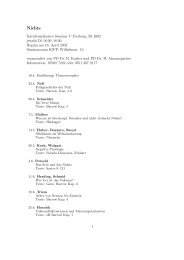
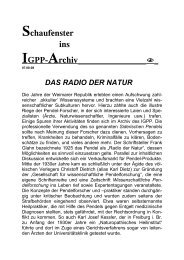
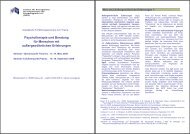
![Findliste Nachträge1 [pdf] - IGPP](https://img.yumpu.com/22552359/1/184x260/findliste-nachtrage1-pdf-igpp.jpg?quality=85)

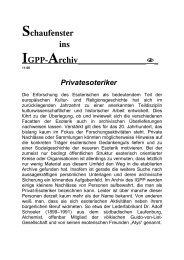
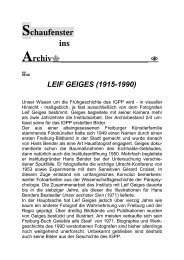
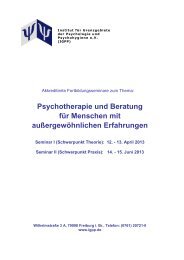
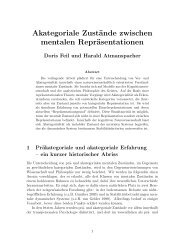
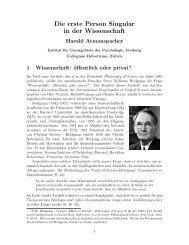
![Findliste [pdf] - IGPP](https://img.yumpu.com/22552265/1/190x245/findliste-pdf-igpp.jpg?quality=85)

